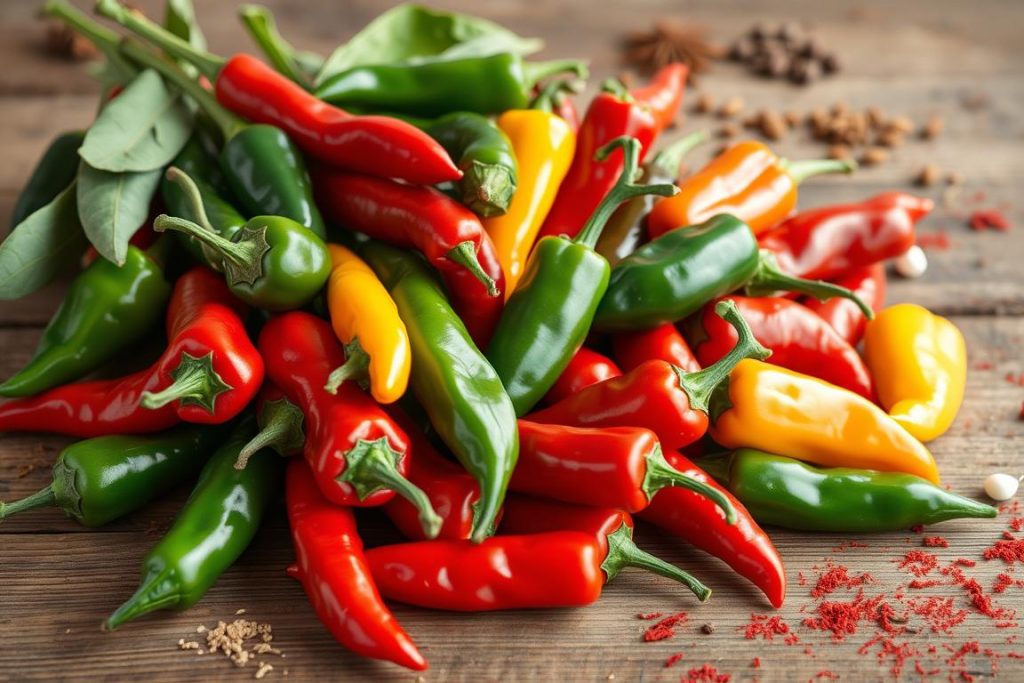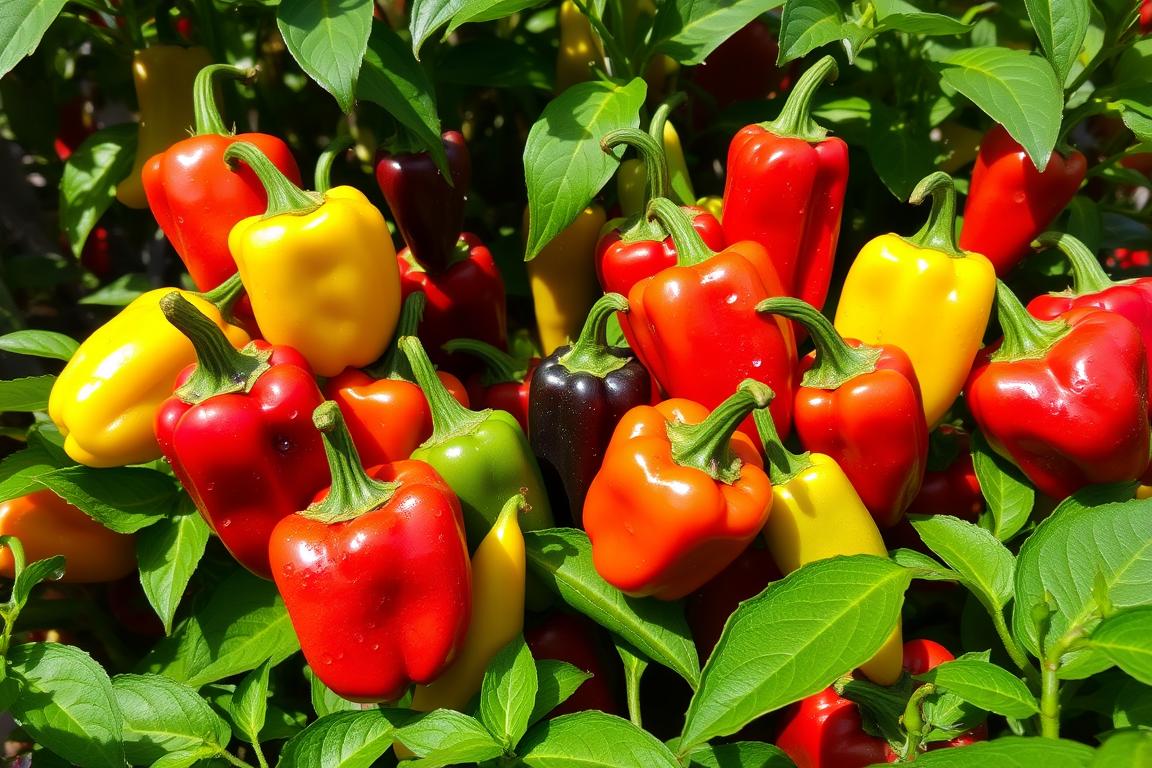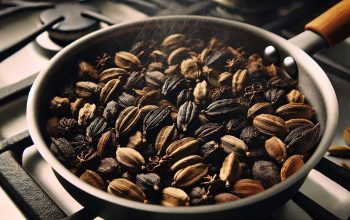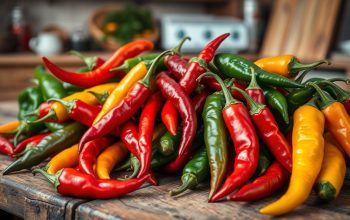Creating the perfect chili is all about finding the right mix of heat and flavor. We’ll look at different chili peppers, the Scoville scale, and how to make your chili both spicy and flavorful. This will make your taste buds happy.
If you’re new to cooking or want to get better at making chili, this article is for you. We’ll share tips to help you make your Mexican dishes even better. Let’s explore the world of chili heat together and learn how to make a dish that will impress everyone.
Understanding the Basics of Heat Levels in Chili
Chili peppers’ heat is key to a dish’s success. This heat comes from capsaicin, which activates pain receptors in our bodies. It’s what makes chili peppers feel hot.
The Science Behind Capsaicin
Capsaicin is the main heat-maker in chili peppers. It works with TRPV1 receptors, which also respond to heat and chemicals. The more capsaicin, the spicier the pepper.
Measuring Spiciness: The Scoville Scale
The Scoville scale measures chili pepper heat. It was created by Wilbur Scoville in 1912. It ranges from 0 (for bell peppers) to over 2 million (for the Carolina Reaper). Knowing the Scoville scale helps you pick the right peppers for your recipes.
Common Chili Pepper Varieties
- Jalapeño (2,500-8,000 Scoville Heat Units)
- Serrano (10,000-25,000 Scoville Heat Units)
- Cayenne (30,000-50,000 Scoville Heat Units)
- Habanero (100,000-350,000 Scoville Heat Units)
- Ghost Pepper (855,000-1,041,427 Scoville Heat Units)
Knowing the heat levels of different peppers is crucial for making tasty dishes.
Essential Ingredients for Authentic Chili Making
Making a real chili dish is like an art. It needs the right chili ingredients. In Mexican cooking, chili peppers and spices are key. They add a mix of heat and flavor to every bite.
The best chili starts with the right chili peppers. You need Ancho chiles for their smoky taste and Serrano peppers for their fiery flavor. Spices like cumin, oregano, and garlic add their own special smells and tastes.
The base ingredients are also important. Ground beef, tomatoes, and beans make the chili thick and full of flavor. They give the dish a rich taste and a good texture.
| Essential Chili Ingredients | Description |
|---|---|
| Chili Peppers | Ancho, Chipotle, Serrano, Jalapeño, Habanero |
| Spices | Cumin, Oregano, Garlic, Coriander, Cinnamon |
| Base Ingredients | Ground Beef, Tomatoes, Beans (Pinto, Red Kidney) |
Choosing and mixing these chili ingredients carefully is key. Whether you’re a home cook or a pro chef, you can make a chili that truly shows off Mexican cuisine.
Balancing Spice and Flavor in Traditional Mexican Cuisine
In Mexico, balancing spice and flavor is a cherished tradition. The country’s diverse regions each have their own chili pepper blends and cooking ways. These contribute to the rich flavors of Mexican dishes.
Regional Spice Variations
The geography of Mexico has led to many regional chili recipes. In the Yucatan, the habanero pepper adds a fruity heat to dishes like cochinita pibil. In central states, ancho and pasilla chiles are used in mole sauces that wow the taste buds.
In the north, chipotle and guajillo peppers shine in red enchiladas and chiles rellenos.
Traditional Mexican Chili Preparation Methods
The secret to Mexican chili’s true taste lies in traditional cooking methods. Recipes often involve toasting, searing, or charring peppers. This step boosts their flavors and aromas.
Slow-cooking the chili in broths or sauces blends the heat with other flavors. This creates a perfect balance of spice and richness.
Combining Different Pepper Types
- Mexican cooks blend chili peppers for a rich flavor.
- They mix mild peppers like ancho with hot ones like chilaca. This controls the heat and adds depth.
- These blends not only improve dishes but also honor long-standing traditions.
Spice and flavor balance in Mexican cuisine is a fine art. Each region and recipe brings its own twist to this beloved tradition.
Perfecting the Beef and Bean Base
Making the perfect chili base is key to a great beef chili or bean chili. It’s important to get the beef and beans just right. This ensures your chili is hearty and full of flavor.
Choose leaner beef like ground chuck or sirloin. This keeps the chili rich without being too greasy. Make sure to brown the beef well. This step locks in the savory flavors.
For beans, kidney or pinto beans from a can are best. Rinse them well to get rid of any bad tastes. You can also use dried beans for a thicker texture. Try different beans to find your favorite mix.
| Ingredient | Quantity | Purpose |
|---|---|---|
| Ground beef | 1 lb | Provides the meat base |
| Kidney beans | 1 (15 oz) can | Adds body and texture |
| Pinto beans | 1 (15 oz) can | Complements the kidney beans |
| Onion | 1 medium, diced | Provides aroma and depth of flavor |
| Garlic | 3 cloves, minced | Enhances the overall taste |
By choosing and preparing your beef and beans carefully, you’ll make a strong, tasty base. This lets the spices and seasonings in your chili really stand out.
Secret Techniques for Building Complex Heat
Making the perfect chili is like an art. The secret is in spice layering. By adding spices at the right time, you can make your chili’s flavor deep and interesting.
Layering Spices Throughout Cooking
Spice layering is key to complex heat. Don’t add all spices at once. Start with aromatic spices like cumin, garlic, and onion. Then, add hotter peppers as it cooks.
This way, the heat builds up slowly. It makes your chili taste rich and layered.
Timing Your Spice Additions
When you add spices matters a lot. Put milder spices in early to soak into the chili. Save hotter peppers for later to add a fiery kick without overpowering.
Try different times to find the perfect mix for you.
Heat Control Methods
- Adjust the heat source: Change the heat level to control the chili’s heat.
- Incorporate cooling ingredients: Sour cream or yogurt can cool it down. Lime juice or vinegar can balance the spiciness.
- Utilize thickening agents: Cornstarch or masa harina can make it creamier and milder.
Mastering spice layering, timing, and heat control makes a chili that excites your senses. Use these secrets to create a dish that will have everyone wanting more.
Managing Heat Levels for Different Palates
Chili isn’t one size fits all. Everyone has their own spice level. To make the perfect bowl, you need to adjust the heat for different tastes. Luckily, there are ways to customize the spice level so everyone can enjoy your homemade chili.
First, understand your audience. Know how much heat your guests or family can handle. For those who like it mild, use Anaheim or poblano peppers. Spice lovers can enjoy habaneros or ghost peppers.
- Change how many chili peppers you use to control the heat level.
- Try different pepper types to customize the flavor and find the right mix of heat and taste.
- Add cool ingredients like sour cream, avocado, or lime juice to reduce the spiciness for those who can’t handle it.
Finding the right heat level is key. You want the chili’s spicy kick to enhance the other flavors without being too much. With some trial and error, and knowing what your guests like, you can make a chili that pleases everyone.
“The perfect chili is a balance of spice and flavor, not just a test of endurance.”
Cooling Ingredients and Their Strategic Use
Using cooling ingredients can change how you enjoy chili. It’s all about finding the right balance of flavors. This way, everyone can find a chili they love.
Dairy-Based Solutions
Dairy products like sour cream, yogurt, or milk can cool down chili. They make the dish less spicy, perfect for those who can’t handle too much heat. Their creamy texture and cooling effect make chili more enjoyable.
Alternative Heat Reducers
There are other ways to cool down chili besides dairy. Avocado, lime juice, or honey can also help. These ingredients add flavor and make chili more appealing to different tastes.
| Cooling Ingredient | Effect on Heat | Additional Benefits |
|---|---|---|
| Sour Cream | Significantly reduces heat | Provides a creamy, tangy contrast |
| Avocado | Moderately reduces heat | Adds a rich, buttery texture |
| Lime Juice | Mildly reduces heat | Adds a refreshing, acidic note |
| Honey | Mildly reduces heat | Provides a subtle sweetness |
By adding these cooling ingredients, you can make chili for everyone. It can be spicy for some or mild for others. This way, everyone can enjoy a great chili.
“The key to a truly exceptional chili is the ability to balance the heat and the flavor, allowing each element to shine and complement the other.”
Common Mistakes to Avoid When Spicing Chili
Making the perfect chili is all about finding the right mix of spices and flavors. Even seasoned cooks can make mistakes that affect the taste and heat. Knowing these common errors helps you make a chili that’s just right.
One big mistake is adding too much spice. It’s tempting to keep adding chili peppers or spices, but this can make the dish too strong. Always follow the recipe and taste as you go. This way, you can adjust the spice to get it just right.
Another mistake is not toasting or blooming spices before adding them. This step brings out the spices’ full flavor and aroma. Make sure to toast or bloom the spices before adding them to your chili.
- Avoid over-spicing your chili by following recipe measurements and tasting as you go.
- Ensure you properly bloom or toast the spices before adding them to the chili for maximum flavor.
- Be mindful of the timing and order of spice additions to create a harmonious spice balance.
- Experiment with different chili pepper varieties to find the perfect flavor enhancement for your personal taste preferences.
| Common Chili Cooking Errors | Solutions |
|---|---|
| Over-spicing the dish | Follow recipe measurements and taste as you go |
| Neglecting to properly bloom or toast spices | Take the time to gently toast or bloom the spices before adding them |
| Improper timing and order of spice additions | Be mindful of the timing and order of spice additions to create a harmonious balance |
| Relying on a single chili pepper variety | Experiment with different chili pepper varieties to find the perfect flavor enhancement |
By avoiding these common chili cooking errors and focusing on the right spice balance and flavor enhancement, you can make your chili incredibly delicious.

Conclusion
We’ve looked into the world of chili, from heat levels to flavor balancing. We’ve learned about the Scoville scale and how to make traditional Mexican chili. This guide has given you the tools to improve your chili-making.
The secret to great chili is mixing spice and flavor just right. By adding spices carefully and controlling heat, you can make chili that everyone will love. It’s important to adjust the heat and add cooling ingredients to balance it out.
Mastering chili is a journey of trying new things and getting better. By focusing on chili mastery, spice balancing, and flavor optimization, you’ll make chili that impresses everyone. Start this tasty journey and let your creativity shine in your chili-making.



